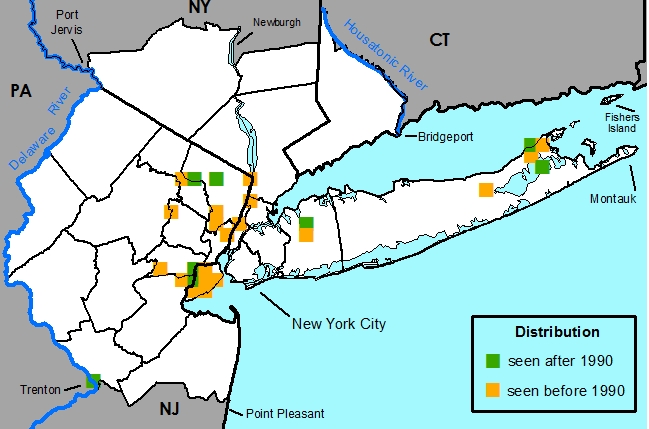Populus heterophylla L. - Swamp Cottonwood, Swamp Poplar, Black Cottonwood, Downy Poplar, River Cottonwood, Bigleaf Cottonwood
Common Names
Swamp Cottonwood, Swamp Poplar, Black Cottonwood, Downy Poplar, River Cottonwood, Bigleaf CottonwoodField Identification
Tree with simple opposite leaves.Nomenclature
Populus heterophylla L., Sp. Pl. 1034. 1753.
Populus carolinensis Foug., Mem. Soc. Agric. France. 1786: 90. 1786. not Moench 1785.
Populus cordifolia Burgsd., Anleit. Anplfanz. 2: 177. 1787.
Populus argentea Michx. f., Hist. Arb. For. Am. Sept. 3: 290, t. 9. 1813.
Populus hetrophylla var. argentea (Michx.) Wesmael in De Cand. Prodr. 16,2: 326. 1868.
Aigiros heterophylos Raf. ex B.D. Johnson, Index Kew. 1: 66. 1893.
TYPE: unknown
Description
HABIT Perennial, deciduous, phanerophytic, tree, diclinous and dioecious, to 30 m tall; with the main bole up to 90 cm in diameter.
STEMS Main stems erect, round. Bark ridged, not exfoliating, gray-brown or brown. Branches erect to ascending. Twigs brown to reddish-brown, smooth with lighter lenticels sometimes apparent, not odoriferous, terete, 3-5 mm in diameter, glabrous or with light brown to light gray tomentum, sparse to dense, distributed throughout (tomentum usually restricted to 1st year twigs), glabrescent, eglandular. Pith orange-brown, round, continuous, nodal diaphragm absent. Sap translucent. For a review of the root system see Pregitzer, 2002 and Stettler et al, 1996.
BUDS Terminal and axillary present, monomorphic, scattered along stem, occasionally viscid. Terminal bud ovoid, blunt to somewhat pointed; axillary buds 1 per axil, ovoid, blunt to somewhat pointed. Bud scales dark brown or brown, imbricate, chartaceous, glabrous or with long and unbranched light brown or light gray hairs, sparsely distributed throughout, eglandular. Bud scale scars not encircling the stem. Leaf scars crescent-shaped. Vascular bundle scars 3, crescent-shaped.
LEAVES Alternate, simple, 1 per node, spaced somewhat evenly along and divergent from stem. Stipules present, lateral, caducous, free from the petiole, small leaf-like. Leaves petiolate, petiole terete (sometimes flattened near summit), 2-9(15) cm long, usually with sparse to dense light gray to light brown tomentum, distributed throughout, occasionally glabrous (sometimes glabrescent), eglandular. Leaf blades: abaxial surface light green, adaxial surface green, widely ovate, bilaterally symmetric, 6-20(25) cm long, 4-13(18) cm wide, chartaceous, base obtuse or cordate to subcordate, margin serrate- crenate, apex acute or sometimes rounded, abaxial surface with light brown or light gray tomentum, sparsely to densely distributed throughout or distributed along midveins; glabrescent, eglandular. Adaxial surface glabrous or with light brown or light gray tomentum, sparsely or moderately dense, usually distributed along midveins and basally, occasionally distributed throughout; glabrescent, eglandular. For a study of the leaf epidermis structure including type of stomata, presence of unicellular and multicellular hairs as well as papillae see Pautov et al., 2003 (In Russian). For an overview of the secondary leaf tissues see Stettler et al, 1996.
FEMALE INFLORESCENCES Unisexual, axillary raceme, 5 to 15 cm long, pendant, catkin-like; precocious, formed on last season's growth. Peduncle and rachis glabrous, eglandular. Bracts 1, subtending each flower, petiolate, apices erose, lateral surfaces glabrous, eglandular; adnate to pedicel. Pedicel 3-15 mm long, glabrous, eglandular, lengthening in fruit.
FEMALE FLOWERS Perianth parts indistinguishable from one another, fragrance absent. Gynoecium set on semi-persistent perianth which is a glabrous, eglandular crateriform disk composed of connate tepals (perigon). Carpels 2-3. Locules 1. Stigmas 2-3, bifid, dialated. Styles 1. Ovary superior, ovoid, glabrous, eglandular. Placentation parietal.
MALE INFLORESCENCES Unisexual, axillary raceme, 5 to 10 cm long, stiffly pendant, catkin-like; precocious, formed on last season's growth. Peduncle and rachis glabrous, eglandular. Bracts 1, subtending each flower, petiolate, apices erose, lateral surfaces glabrous, eglandular; adnate to pedicel.
MALE FLOWERS Perianth parts indistinguishable from one another, fragrance absent. Androecium set on semi-persistent perianth which is a glabrous, eglandular crateriform disk composed of connate tepals (perigon). Stamens 12-20(35), exserted. Anthers dehiscence longitudinal, glabrous, eglandular. Filaments free, straight, glabrous, eglandular. Gynoecium absent.
FRUITS Loculicidal 2-3 valved capsule, ovoid, 7-12 mm long, glabrous, eglandular.
SEEDS Minute, glabrous, eglandular; adnate tufts of longer "cotton" (which facilitate anemochory) composed of epidermal hairs of the placenta; endosperm completely consumed by developing embryo so that none remains in the mature seed (Nagaraj, 1952). Weight - 0.3-0.6 mg (Bessey, 1904) (Burns & Honkala, 1990).
Habitat
Swamps and wet bottomlands.Distribution
Indigenous to the eastern United States.
United States -- AL, AR, CT, DE, FL, GA, IL, IN, KY, LA, MA (Searcy et al., 2001), MD, MI, MO, MS, NC, NJ, NY, OH, PA?, RI, SC, TN, VA
New York Metropolitan Region -- Native, found in isolated populations in coastal areas of NJ and NY in the metropolitan area.
Rarity Status
Global Heritage rank -- G5
Connecticut -- S1
New Jersey -- S2
New York -- S2
Species Biology
Flowering
April - May
Pollination
Anemophliy
Fruiting
May - June
Dispersal
Anemochory and Hydrochory (Fowells, 1965)
Germination
It is difficult to define germination with the small seeds of Populus species; for most species; germinated seedlings should have well-developed hypocotyl hairs, regular growth, and a geotropic response. Seeds that have been dried for storage may suffer injury from rapid imbibition; aeration with humid air after storage has been used to solve this problem. The critical factor for germination is moisture. (Young & Young, 1992)
The time of ripening is quite variable; a safe criterion for time of fruit collection is when a small percentage of the capsules are beginning to open. Pre-strorage drying immediately after collecting is essential for successful storage. A moisture content of 5-8% improves viability and germination of stored seed. After air drying for 4 days store in a sealed container at 41d F. The critical factor for germination is moisture. (Dirr & Heuser, 1987)
Seeds probably have a short viability (Fowells, 1965).
Long term viability can be maintained with temperatures below freezing in a dry atmosphere. (Stettler et al, 1996)
